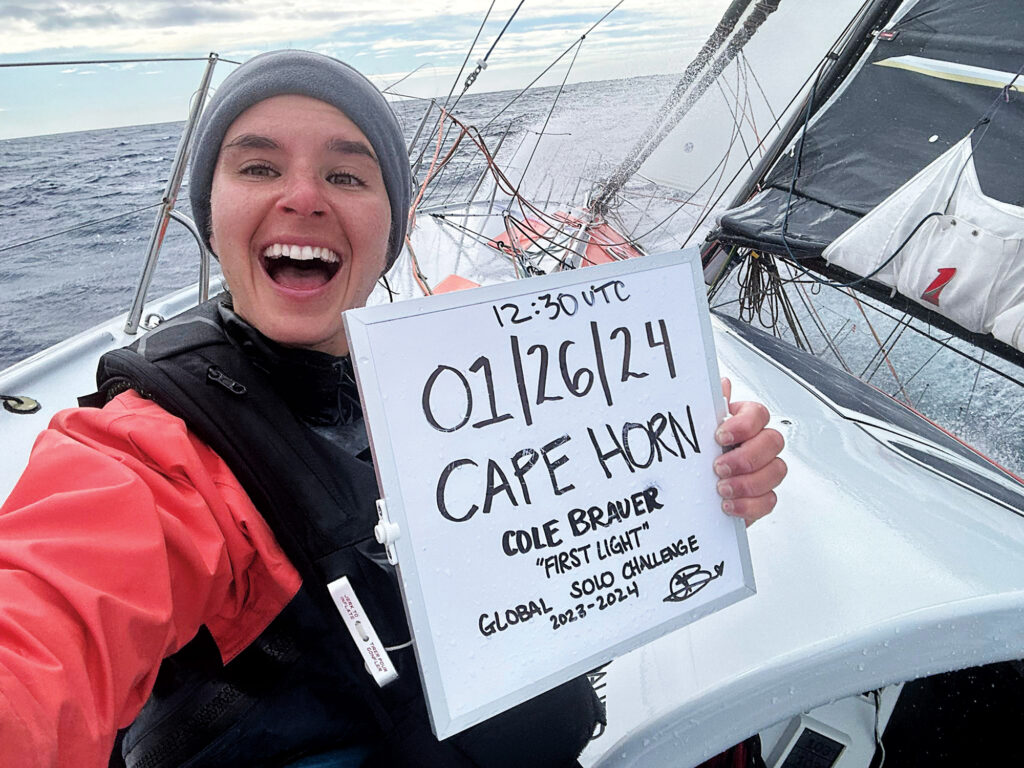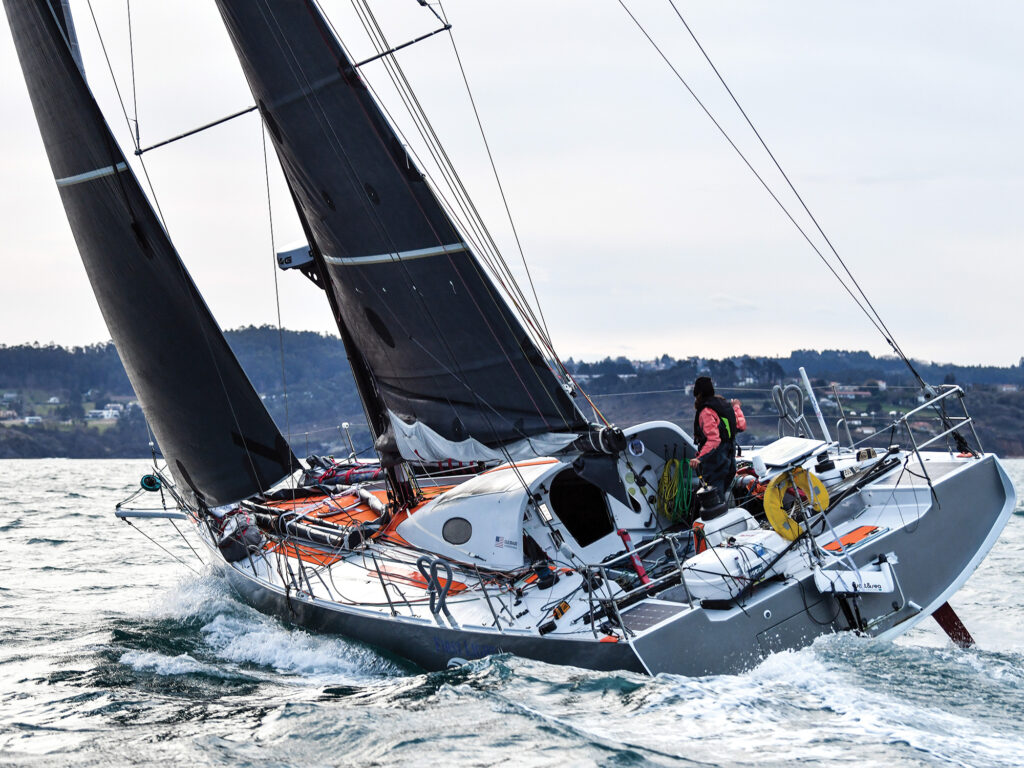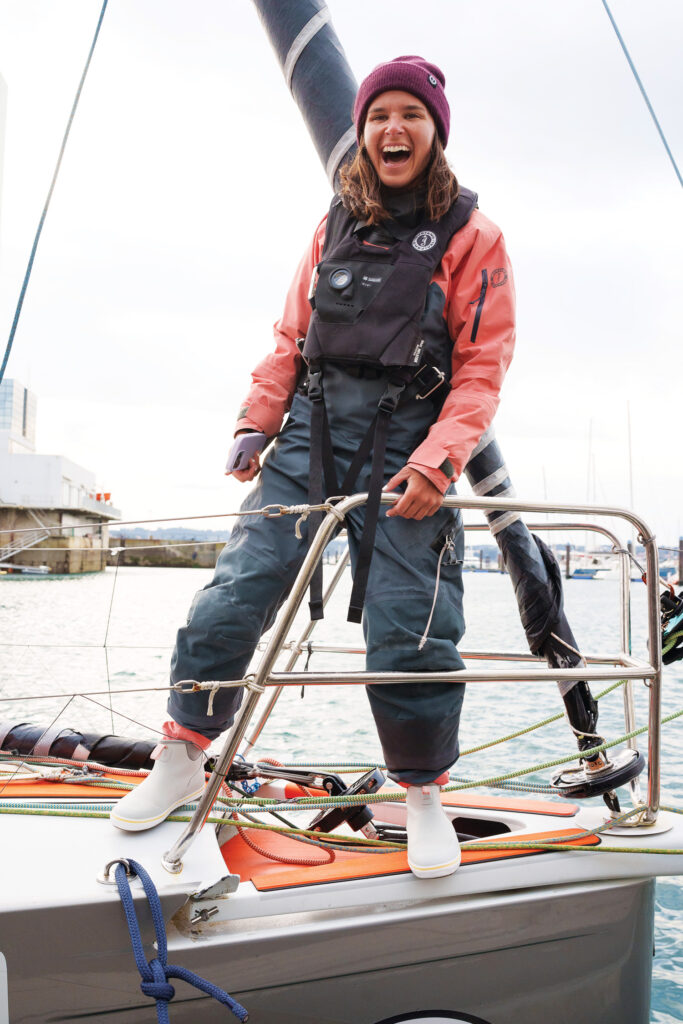
Within a day of setting out on the Global Solo Challenge, Cole Brauer wakes up from a nap with an urge to puke. She’s never been seasick in her life, so she assumes food poisoning. Whatever the cause, there’s no stopping it, and as vomit turns to bile, she can’t stop crying. The rigging of her Class 40, First Light, shrieks as she lies fetal on the cockpit floor, the boat pitching in 10-foot seas and 50-knot gusts. She’s not far from shore, but she’s never felt so alone.
Then, like a guardian angel, a voice comes over her phone speaker. “Get up, Cole,” says her onshore weather router, Chelsea Freas. “You have to tack the boat.”
“There’s no way on God’s green earth I can tack this boat right now,” Brauer gurgles, lying face down in her last meal.
“I don’t care what you have to do,” Freas says. “Get your shit together and tack the boat. You are pointed toward Greenland right now.”
But Brauer doesn’t care which way the boat is headed. It might as well be pointing everywhere and nowhere at once. The seas surge, her body floats in nothingness. A gray wind. A gray ocean. One wave comes, then another.
“Get up, Cole!” Freas repeats. “You didn’t come all this way to quit now.”
Brauer takes the comment as a challenge, and like so many times before, she answers it. She sets down her phone, gulps, and gets to work transferring the sail stack from one side of the boat to the other. When all the sails have been shifted, she readies herself at the back of the boat, one hand on the tiller, the other on the winch, ready to break the jib. She times the turn on a wave, and once the sails refill, she collapses again.
“Cole?” Freas asks. “Are you still there?”
“I’m here,” Brauer responds. “Where else would I be?”
four months earlier, in June 2023, Brauer is on a call with her sponsor, F.K. Day, to negotiate the next phase of her racing partnership. She has just won the Bermuda One-Two, and when she floats the idea of entering the Global Solo Challenge, she is using it primarily as a bargaining chip. She figures there’s no way Day will pony up $1 million for an audacious around-the-world campaign, so she hopes he will settle for her second choice: the Transat Jacques Vabre, a doublehanded trans-Atlantic race.
But Day surprises her with a simple question: “Which one do you think you can win?”
With their vintage 2008 Class 40, racing against the new-generation boats of the TJV and expecting a win would be a fool’s errand. The Global Sailing Challenge fleet, however, is beatable. “Let’s go big or go home,” Day says. “If you want to race around the world, this is your chance right now.”
On the Fourth of July, Brauer has less than 90 days to outfit her boat in Newport, Rhode Island, and deliver it to the start port in A Coruña, Spain. She has never led a project of this scale before, and what was a $300,000 program is now a million-dollar effort with a full support team in tow.

“We realized very quickly it was going to be more,” Brauer says. “From flights to lodging to food and people’s salaries, plus the boatwork, to run a fully professional program was going to cost a lot of money to do the right way.”
She assembles her squad in a few different phases, starting with her media team: photographer, videographer, and a social media and marketing manager. She then hires a project manager and buys 10 brand-new sails. She retains a medical team to stand by 24 hours a day during the race, and after replacing all the batteries and electronics and loading the boat with spares, the only thing left to do is make the start.
The Global Solo Challenge features a pursuit-start format, and by the time her starting window opens on October 28, a few of her competitors are already well down the Atlantic. The day she is scheduled to set out, a low-pressure system with gale-force winds keeps her in port, but after a day of waiting, she crosses the starting line at 5:38 a.m. local time through a shroud of morning darkness, thrashing upwind in the remnant gale.
“I had a good idea of what I was getting myself into,” she says. “I felt strong and quite confident and not nervous whatsoever about leaving.”
Elation turns to nausea, and then she’s on the cabin sole. “Thank God my medical team was there,” she says. “They were shoving me with drugs, trying to get me to stop throwing up. They were talking me through it, reassuring me that everything was going to be OK.”
Brauer eventually administers herself an IV, sharing the experience with her Instagram followers in what will be one of many brutally honest and emotional “shares” with several hundred thousand people she does not know. Despite well wishes inundating her social media feeds, tears flow daily. Not all day long, but every morning, she thinks about her friends in Newport or her parents in Maine, and sure enough, the tears come again.
“I had such a good community, and then, with no weaning-off period, I was just shoved out into the middle of the ocean all by myself,” she says. “That was probably the hardest thing I’ll ever do. I was having a really rough time.”
Over the next month, Brauer is jockeying for position on the way south, past the Cape Verde Islands, through the Doldrums, and straight into the Southern Ocean for her baptism of fire. “The waves in the Southern Ocean have a different level of violence not trainable anywhere else in the world,” Brauer says.

One broaching wave in particular gives her a true taste of more to come. She’s thrown clear across the cabin and lands on her right rib cage. Video of the incident, shared around the world thanks to her Starlink terminal, goes viral, but harder moments are ahead. The boat’s autopilot ram blows a gasket during the broach, so she heaves-to and crawls into the cramped rudder compartment to fix it. With her ribs throbbing, she replaces the primary autopilot ram with her secondary unit, but a few days later, she discovers that a piece which attaches to the quadrant has unthreaded itself, so she’s spelunking for another fix. “Everything that could go wrong was starting to go wrong,” Brauer says.
At this point, she’s in a part of the Southern Ocean they call “The Train,” where low-pressure systems come one after another, with dramatic changes. “The northwesterly [wind] is a lot calmer,” she says. “A lot less shifty, a lot less cold. And then it switches to the southwesterly, which comes from Antarctica, which is the scary breeze. The way the wind comes down from the upper atmosphere makes it super-violent and unstable.”
Here in The Train, she soon discovers water pouring through the rudder bearings and onto the electronic rudder unit, which eventually dies. “The last 24 hours, I’ve been so angry,” she shares on a video dispatch. “And not angry at one thing in particular. Just angry. Angry that things keep going wrong. Angry that the rudder reference thing has happened. Angry that my ribs hurt so bad.”
She has to wait three days for the wind to abate so that she can calibrate the new rudder reference, which is something people typically do at the dock. She has Freas route her to a calm spot, allowing her to stop the boat completely, and even then, she isn’t happy with the job, given how bad the sea state is.
“I was nervous because there was still so much water coming through the rudder bearing, so I made a little raincoat for the rudder reference, which was just a Ziploc bag and some tape. I poured baby powder on top of the unit so that I could look into the bag and see if the powder was still dry, then I knew I didn’t have to replace the plastic bag.”
Through weeks of hard work and grit, her rib injury subsides and rudder issues wane. When she rounds Cape Horn on January 26, 2024, she is the first American woman to sail past the three great capes. She announces her procession to her Instagram following, which will grow from 2,300 followers to nearly half a million by the end of the race. Her unique ability to make hardcore ocean racing look fun and sometimes silly is resonating with an audience who likely doesn’t know bow from stern. With quirky videos of her vibing on the boat, she manages to captivate followers well beyond the sailing bubble.
“We didn’t do it for the numbers,” Brauer says. “We didn’t go out and buy our followers. We just wanted everything to be organic, and I think we got a big following because we weren’t too pushy about anything. Every day, we made between 2,000 and 7,000 followers steadily, until I got to the finish.”
On March 7, as first light pokes through the clouds off the coast of Spain, Brauer stands on the back of her boat with a pair of marine flares, per tradition, and crosses the finish line, second overall to Frenchman Philippe Delamare by 11 days. She’s celebrated as the first American woman to race nonstop singlehanded around the world, and the reception in A Coruña is a flurry of hugs, kisses and champagne. With superhuman adrenaline, she powers through a daunting schedule of network-news interviews—an overnight media darling featured by every major news outlet in the US. Her and her media manager’s phones are ringing off the hook: endorsements, book deals, documentaries, and speaking arrangements all in demand. Reporters ask her ad nauseam what it means to have finally achieved her goal. She talks about how great everything was, but in truth, all the attention just makes her want to get back on the ocean and do it all over again.









